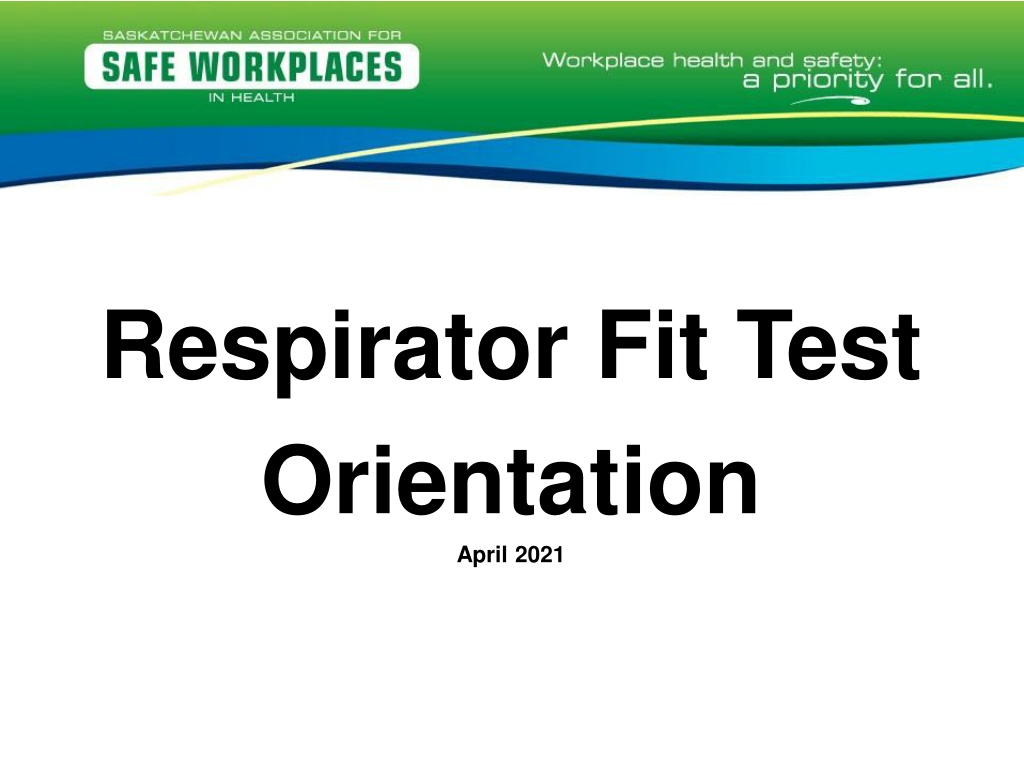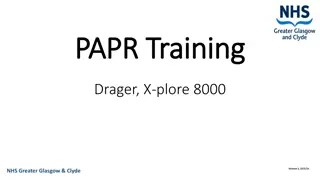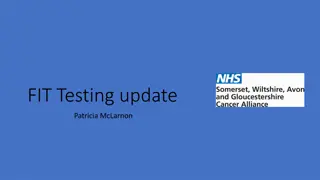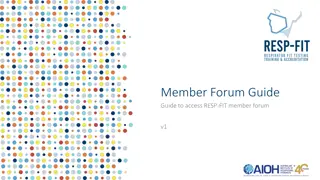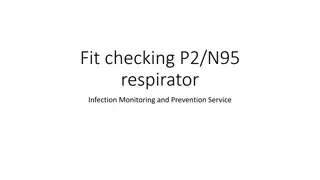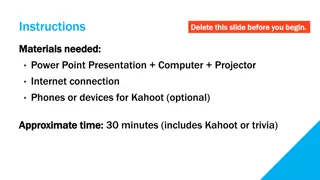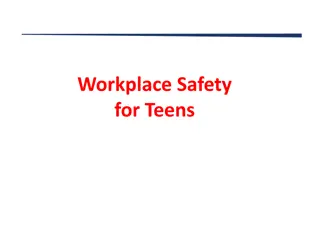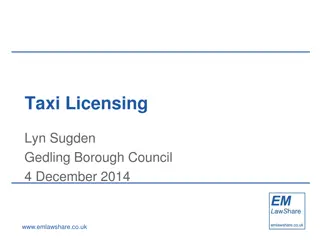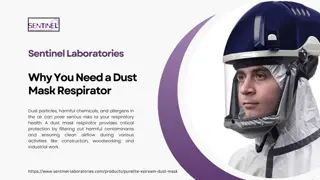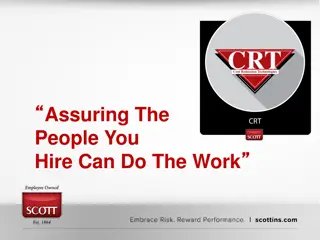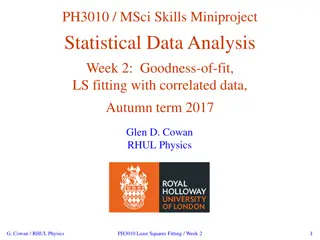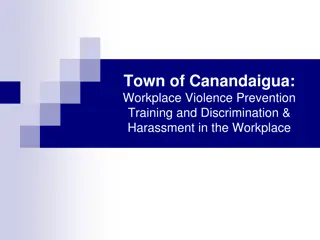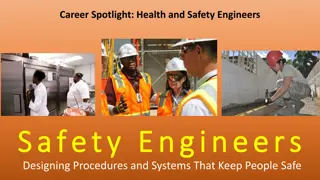Respirator Fit Testing and Workplace Safety Overview
This content provides information on respirator fit testing, the difference between surgical masks and respirators, legislative guidelines in Saskatchewan, worker rights, and CSA Standard Z94.4-18. It covers the process of identifying the correct respiratory protection for workers, ensuring proper application and maintenance, practical demonstration, and the importance of achieving a tight seal with respirators. The CSA standard sets out responsibilities for employers, program administrators, supervisors, and fit testers to ensure workplace respiratory safety.
Download Presentation

Please find below an Image/Link to download the presentation.
The content on the website is provided AS IS for your information and personal use only. It may not be sold, licensed, or shared on other websites without obtaining consent from the author. Download presentation by click this link. If you encounter any issues during the download, it is possible that the publisher has removed the file from their server.
E N D
Presentation Transcript
Respirator Fit Test Orientation April 2021
HousekeepingDetails http://www.notobacco.org/photos/large/photo07.gif http://www.diyderby.co.uk/ekmps/shops/bartlam/images/emergency-exit-sign-300-x-200-code-1516-1024-p.jpg
What is Fit Testing Process to identify the correct make, model and size of respiratory protection for workers Includes information to ensure workers understand the proper application, maintenance and pre-use testing for respiratory protection Includes practical demonstration that a worker can competently don and doff the respirator
There is a Difference Surgical/procedural mask Most commonly used Re-usable/disposable Protects the patient/client and the worker Less than 50% effective in protecting worker Marked leakage around the borders of the mask Respirator Worn during air borne event Re-usable/disposable Protects worker from the patient/client and the environment 95% effective Tight seal to the face Must be fitted to the user s face in order to achieve tight seal
Legislation Saskatchewan Occupational Health and Safety Regulations, 2020 3-11 Occupational health and safety program 7-1 Use of equipment required 7-3 Respiratory protective devices 21-8 Respiratory protective devices CSA Standard Z94.4-18
3 Rights of Every Worker Right to Know Right to Participate Right to Refuse unusually dangerous work
CSA Standard Z94.4-18 Sets the standards for workplace respiratory and fit testing programs Sets out roles and responsibilities in a respiratory protection program
CSA Standard Z94.4-18 Employer: has legislated duties Program Administrator: ensures qualified personnel are assigned roles Supervisor: ensures training and testing are complete Fit Tester: completes the fit testing including training component
Fit Testing Respirator User Screening Form must be completed prior to being fit tested Then you will be fit tested You have responsibilities following fit testing
CSA Standard Z94.4-18 Users of Respirators are responsible to: follow all written procedures use, inspection, maintenance, storage follow all requirements for respirator use participate in refresher training and demonstrate ongoing competent use of your respiratory protective equipment protect your own health and safety as well as that of fellow employees inform your supervisor if concerns arise with equipment, process, procedures, health etc., which will affect the safe and efficient use of respiratory equipment remove any respirator from service that you determine is defective and report it to your supervisor perform user seal checks after donning a tight-fitting respirator.
Respiratory Hazards Oxygen deficient Oxygen levels have decreased Never enter suspected or confirmed oxygen depleted environments unless specifically trained to do so Always check with your supervisor Air borne contaminants Biological Dust Vapours Fumes Fibers Gases
Respirators Disposable used once and thrown away Elastomeric re-usable; non-powered and powered Both disposable and elastomeric respirators must be fit tested appropriately
Hazards OH&S Regulations 7-2, 3-11 Know the hazards associated with work tasks Know how to protect yourself Know signs/symptoms that might present themselves in cases of overexposure
Respiratory Fit Test Orientation for everyone User screening form required Fit tester will explain process Following fit testing, know the size and make of respirator for you
Frequency of fit testing At least every 2 years unless: Change in YOUR physical condition such as weight, broken nose Change in respirator Experience discomfort Change in other Personal Protective Equipment
Impact on respirator seal Personal care items: Be clean shaven Severe scarring/acne Facial piercings/heavy sweating Make-up, face creams
User Seal Checks Negative: Air purifying respirators and disposable respirators Positive: Respirators equipped with tight fitting face pieces
Cleaning, Inspection, Maintenance and Storage Cleaning Sanitization Inspection Testing Repair Storage Recordkeeping Cautions/Limitations: Know the cautions/limitations of the respirator fitted for you. This can be found on the packaging or on the instruction sheet from the manufacturer.
Before being fit tested ensure you do not eat, drink (except plain water), smoke, eat candy or chew gum for at least 15 minutes before the test is conducted be clean shaven - facial hair will interfere with an effective respirator seal present yourself in the same personal condition you would expect to be in when using the respirator: wear your eye glasses/contact lenses/dentures that you would normally wear have your hair in the manner you do when at work (e.g., hair bun) include any personal protective equipment (such as eye protection/face shield) understand that personal accessories, such as head coverings, garments, facial jewellery or other items shall not come between the skin and the sealing surface of the respirator, as well as make-up, creams and lotions may interfere. Ensure you are on time for your fit testing. It is an investment in your safety.
Be Aware Be Healthy Be Safe Contact Us: INSERT YOUR NAME/CONTACT NAMES ENTER YOUR PHONE/EXTENTION
